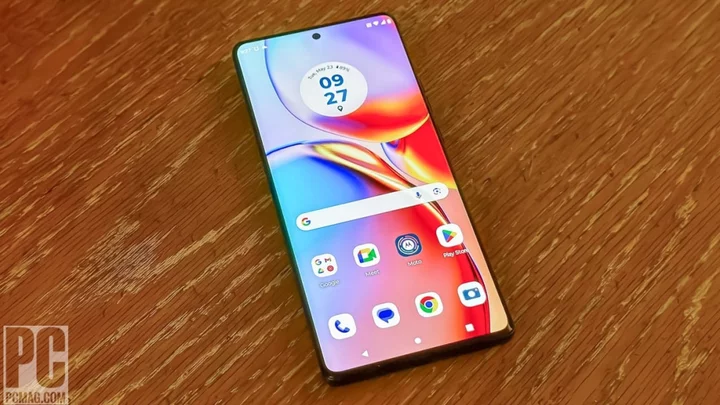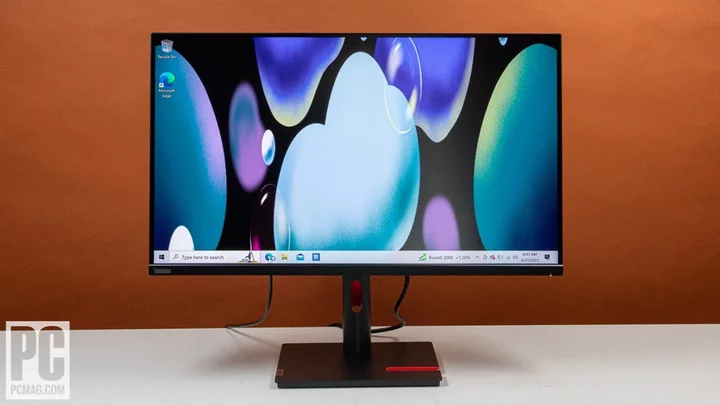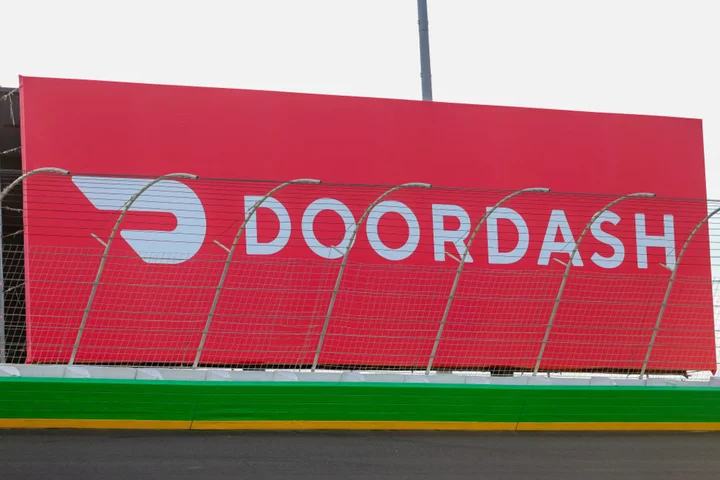Motorola has carved out a niche for itself as a company that makes quality affordable phones. The $799.99 Moto Edge+ is a flagship that undercuts much of the competition with excellent performance at a surprisingly reasonable price. Motorola makes several welcome changes over last year's Edge+ by boosting the waterproof rating, adding telephoto zoom, and improving its software upgrade schedule. The 2023 Edge+ has plenty of competition in this price range including the OnePlus 11 5G ($699.99), the Samsung Galaxy S23 ($799.99), the Apple iPhone 14 ($799.99), and the Google Pixel 7 Pro ($899.99). But with superior performance, support for rapid wired charging, and stellar battery life, the Moto Edge+ edges out the competition to earn our Editors' Choice award for Android flagships under $1,000.
Stunning Visual Appeal
It’s hard not to be impressed by the Moto Edge+ when you pull it out of the box. The rounded edges—which make the Edge+ the Edge+—aren’t as popular a design element as they once were but somehow manage to feel novel and innovative again. The phone is almost entirely without bezels surrounding the large display.
The phone measures 6.34 by 2.91 by 0.34 inches (HWD) and weighs 7.16 ounces. That's a bit smaller than the Pixel 7 Pro, which is 6.4 by 3.0 by 0.3 inches and 7.48 ounces. It's also smaller, by a couple of millimeters in height and width, than its predecessor.
The screen measures 6.7 inches and boasts a faster-than-most 165Hz refresh rate, a notable improvement over the 144Hz screen of last year's Edge+. The 360Hz touch rate impresses, too, which makes the phone a better gaming device than the competition. Unfortunately, however, Motorola held the screen back a bit by opting for a pOLED display with a 2,400-by-1,080-pixel resolution and a pixel density of 395ppi rather than a higher-density, 1,440p-based screen. This is the same size and resolution as last year's handset, but the Pixel 7 Pro has a 6.7-inch screen with a 3,210-by-1,440-pixel resolution that generates a richer 512ppi density.
With a peak brightness rating of 1,300 nits, screen visibility shouldn't be much of an issue. We tested the phone outside in direct sunlight with the brightness turned all the way up, and we could see it perfectly.
Corning Gorilla Glass Victus protects the screen and the device has a competitive IP68 rating for dust and water protection. This is a significant improvement over the IP52 rating of the 2022 Edge+. We expect these durability features on high-end smartphones, and Motorola is (finally) doing it right.
Motorola placed a fingerprint scanner under the display and we found it somewhat finicky. We had to enter our PIN multiple times in lieu of our fingerprint because the phone couldn't read our fingers. The phone also has face recognition, which worked flawlessly in our testing, though it's not as secure as the fingerprint scanner.
The back of the phone is Gorilla Glass Victus with a matte finish that doesn't attract fingerprints while the sides and top are sandblasted aluminum. We're pretty fond of the texture of the rear panel, as it creates a delicate look and feel. The camera system, which features two large lenses, a smaller third lens, and a flash, is positioned in the top-left of the phone's rear panel. A glossy Motorola batwing logo decorates the phone's center. Motorola is only offering the phone in Phantom Black.
You'll find one of the two speakers along the phone’s top edge. The right features the volume and power buttons. On the bottom, you'll find a downward-firing speaker, a USB-C port, and a SIM card tray. As is typical with high-end smartphones, there's no 3.5mm headphone jack.
Based purely on visuals, this a phone anyone would be proud to own. Every detail feels meticulously crafted and it's a joy to look at.
Competitive Performance and Even Better Battery Life
Motorola is powering the Edge+ with the Qualcomm Snapdragon Gen 2 SoC, the top mobile processor available. This is on par with phones like the OnePlus 11 5G and the Galaxy S23. It's a bit harder to compare the Edge+ with the Pixel 7 Pro, as Google's Tensor G2 chip is tuned for different performance factors, such as AI and machine learning. You can only get the Edge+ in one configuration in the US with 8GB of LPDDR5X RAM and 512GB of UFS 4.0 internal storage.
Benchmarks help us compare device performance no matter the processor inside. First, we tested the raw compute power using the Geekbench 5 assessment. In this test, the Moto Edge+ achieved 1,942 on the single-core and 5,106 on the multi-core tests, respectively. The Pixel 7 Pro had notably inferior scores of 1,050 and 3,190. The Galaxy S23, which uses the specially-tuned Qualcomm Snapdragon Gen 2 for Galaxy, scored 1,541 and 4,949. Based on these tests, we're impressed with the CPU performance offered by the Moto Edge+.
PCMark's Work 3.0 benchmark is another test we run on every phone. It evaluates a handset's ability to handle daily tasks like manipulating spreadsheets and editing images. In this test, the Moto Edge+ scored 14,531, which is respectable. The Galaxy S23 scored in the same range with 14,682, while the Pixel 7 Pro scored a bit lower with 11,369. For the Edge+ to score so close to the Galaxy S23, which features an 8 Gen 2 with a slightly higher clock speed, is solid result for the Motorola.
Finally, we pushed the Adreno 740 graphics card's ability to handle complex gaming via the GFXBench 1440p offscreen test. This benchmark is designed to push the phone’s polygon-pushing power. The Edge+ averaged 61fps, which is slightly higher than the Galaxy S23's 58fps and vastly superior to the Pixel 7 Pro's 25fps. This is good news for gamers.
In terms of real-world experiences, we have zero complaints. Everything runs smoothly on the Moto Edge+. We made calls, sent texts, played games, and more, all without a hitch.
As far as gaming is concerned, we ran into playback issues when we attempted to run Genshin Impact at the High graphics settings at 60fps. This is typical, though, as even gaming phones like the Asus ROG Phone 7 Ultimate have to work hard to run the game at maximum settings. When we dialed the game back to Medium at 30fps, though, it ran flawlessly, which isn't surprising considering how hard Genshin can push a phone's GPU.
Battery life might be the most impressive feature of the Edge+. We tested the phone by streaming a YouTube video via Wi-Fi with the screen's brightness maxed out. The 5,100mAh battery lasted an incredible 16 hours and 55 minutes, crushing the S23's 13 hours and 12 minutes and the Pixel 7 Pro's 10 hours and 50 minutes.
The Moto Edge+ features proprietary 68W TurboPower wired charging, 15W wireless charging, and 5W wireless power sharing. We charged the phone by 20% in just 15 minutes with the included 68W wired charger, which is fantastic for such a large battery.
Overall, you can't go wrong with the Moto Edge+. It rivals phones that cost hundreds of dollars more. The battery life, in particular, is a strong selling point.
Strong Mid-Band 5G
Motorola's new Edge+ supports a single physical nano SIM card and an eSim card, so you can use multiple phone numbers with the device if needed.
Most of the important 5G spectrum bands are covered across the three major carriers in the US. All the low- and mid-band sub-6GHz bands are on board, but the phone perplexingly leaves out support for bands n260/261, which would give it mmWave support for Verizon. The bottom line here is, you get sub-6 5G only with the Moto Edge+.
The phone performed admirably on T-Mobile's network, which has excellent coverage in our Danbury, CT, testing zone. When connected to T-Mobile's faster 5G Ultra Capacity network in an area with a powerful signal, the Edge+ reached an impressive 690Mbps down and 61Mbps up. For comparison, the Google Pixel 7 Pro had similar performance with speeds of 685Mbps down and 58Mbps up.
We then took the two phones to an area on the edge of T-Mobile's 5G coverage and ran the same tests. Using the lesser of T-Mobile's 5G services, Motorola's phone offered download speeds of 16Mbps and upload speeds of 2Mbps. Meanwhile, Google's phone hit 12Mbps down and 3Mbps up. We can safely say that the Motorola Edge+ performs as well as competing devices on T-Mobile’s 5G network.
Call quality is outstanding. We tested calls via T-Mobile’s network and everything sounded clear to us and the person receiving our calls. Both the earpiece and the speakerphone stand out, delivering more than enough volume to hear the other party clearly. During calls, we recorded peak volumes of 76.7dB through the earpiece and 96.5dB through the speaker, placing the Edge+ among the louder phones we've tested recently.
We played "Silent Shout" by The Knife to test the stereo, Dolby Atmos-capable speakers, and they sounded good. The bass response had impressive depth and the high notes had impressive clarity. If you like listening to music through your phone's built-in speakers, you'll be happy with the Moto Edge+. Of course, no phone can replace headphones or a larger Bluetooth speaker, but these are better than average.
The Edge+ supports Wi-Fi 6E out of the box and is Wi-Fi 7-ready when the newest spec becomes available. We tested the phone on Wi-Fi 6 against the Pixel 7 Pro to gauge Wi-Fi performance. We started with both phones in the same room as the hotspot where the Moto Edge+ achieved speeds of 765Mbps down and 134Mbps up, and the Pixel Pro scored 755Mbps down and 128Mbps up. We also tested the phones at the edge of the router's range, where the Edge+ achieved 6Mbps down and 1Mbps up, and the Pixel 7 Pro nabbed 7Mbps down and 1Mbps up. In other words, both phones performed similarly with the same Wi-Fi network signal. That's as it should be.
The phone also includes support for NFC for mobile payments and Bluetooth 5.3 for connecting to your favorite wireless headphones.
60MP Selfies
Motorola's latest offers some impressive cameras from a hardware perspective, especially with respect to the selfie camera. The front camera has an whopping 60MP sensor at f/2.2 that takes binned images of 15.1MP, which is as many pixels as other phones' unbinned sensors.
Front camera, portrait modeThe rear cameras are solid, too, with a 50MP primary sensor at f/1.8 (images are binned by a factor of four to 12.6MP), a 12MP, f/1.6 telephoto camera with 2x optical zoom (which was not available on last year's Edge+), and a 50MP, f/2.2 ultra-wide shooter. This is the rear camera trio we expect from modern flagships, and it’s nice to see Motorola is finally on board with the idea.
Main camera, outdoors, daylight Telephoto camera at 2x zoom Main camera, portrait mode, indoors Ultrawide camera, outdoorsWe tested the cameras in various lighting conditions and were pleased with the results. Images from all three cameras appear sharp and crisp in both full sunlight and dark conditions. Further, the portrait mode creates a fantastic bokeh effect with the front and rear cameras, giving images that little something extra. Low-light performance isn't quite as impressive as Google's Pixel 7 Pro, but it'll do the job in a pinch.
Main lens, Night Vision, low lightThe high-resolution primary camera allows the phone to capture up to 8K video at 30fps and 4K video at 60fps. It also supports 1080p slow-motion video at speeds as high as 960fps. Like still images, videos captured with the front and rear cameras look fantastic. The phone supports gyro-electronic image stabilization to help create smooth footage, though it introduces a slight crop to allow the stabilization to work. It's a worthwhile tradeoff because the videos are almost gimbal-like smooth.
The Edge+ includes plenty of capture modes that make taking photos easy, such as Night Vision (which can be activated automatically in low-light situations), full-resolution mode, dual capture, and more. There's a Pro mode for people who like tweaking every aspect of their photo-taking settings, as well.
Overall, we were impressed with the Moto Edge+ cameras. Between the modern lens trio on the rear and the high-resolution selfie camera, Motorola got it right.
Motorola’s Android Is Almost as Good as Stock
One thing we like about Motorola compared to brands like Samsung is that the company doesn't mess with Android too much. It's not the pure stock Android 13 experience offered on the Pixel 7 phones, but it's much closer to stock than Samsung’s OneUI or OnePlus’ Oxygen OS. Of course, some people love Samsung's version of Android, and that's perfectly fine.
Motorola includes some apps and overlays that you may or may not like. For example, when you launch a game, the phone pops up a button that lets you access extra settings such as screen recording and a high-performance mode. When you first boot the phone, there's a popout to guide you through using the phone. The phone expects you to engage with its suggestions, which might be nice for new Android users but could be annoying for more experienced buyers who know what they need. Seasoned Android users might want to pass on these extras, but beginners could find them useful.
The Edge+ has a few notable features you won't find on all Android phones. Ready For, for example, lets you seamlessly connect to a PC or display wirelessly. We're particularly fond of the options offered by My UX, such as the customizable gestures that make navigating the OS faster and more fun to use. The phone also offers style options for customization.
While it won't be particularly useful to average consumers, businesses can use Motorola's ThinkShield to configure and deploy the Edge+ to employees while managing the device remotely.
Samsung still rules for software support, but Motorola is nipping at its heels. Motorola is offering three years of full operating system upgrades and four years of bi-monthly security patches for the Edge+. If you're the type of person who gets a new phone every year or two, this will be more than enough. If you hold onto your phone for multiple years, Samsung might be the better option, as you get one extra Android software upgrade.
On the Edge of Greatness
Together with the recently released ThinkPhone, Motorola has renewed its competitive flagship roster. The Moto Edge+ packs snappy performance, above-average cameras, and excellent battery life into an appealing $800 package. The Edge trounces the Pixel 7 Pro in raw power, produces clearer shots than the OnePlus 11 5G, and far outlasts the Galaxy S23 when it comes to battery life and charging speeds. It's the most of nearly everything you can get in an Android phone for well under $1,000, earning it our Editors' Choice award. If budget isn't a concern, however, the $1,199 Samsung Galaxy S23 Ultra remains our top pick for high-end handsets due to its incredible display, top-notch cameras, and class-leading software upgrade commitment.









